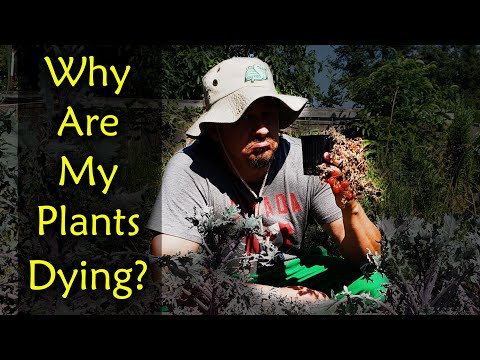Having a garden full of lush and vibrant outdoor plants can be a great source of joy and satisfaction. Unfortunately, keeping your plants alive and healthy isn’t always easy. If you’re noticing that your outdoor plants are dying, it can be frustrating and disheartening. In this article, we’ll discuss the common causes of outdoor plant death, as well as what you can do to prevent it from happening.There are several possible reasons why your outdoor plant may be dying. It could be caused by a lack of sunlight, too much water, an infestation of pests or disease, or a nutrient deficiency in the soil. If the plant is in a container, it may also need to be repotted with fresh soil. Check for any signs of pests or disease and determine if the plant is getting enough light and water for its needs. If the soil lacks essential nutrients, fertilize it accordingly.
Common Reasons For Outdoor Plant Death
Outdoor plants are subject to a variety of environmental factors that can cause them to die. Some of the most common reasons for outdoor plant death include overwatering, underwatering, extreme temperatures, pests and diseases, nutrient deficiencies, and poor soil conditions.
Overwatering is one of the biggest causes of outdoor plant death. Too much water can lead to root rot, which can kill a plant in a matter of days. To prevent this from happening, make sure you are only watering your plants when the soil is dry to the touch and never leave standing water around the base of your plants.
Underwatering is also an issue that can lead to outdoor plant death. When plants don’t get enough water they become dehydrated and can start to wilt or die. Make sure you check the soil before watering and properly water your plants depending on their needs.
Extreme temperatures can also be a factor in outdoor plant death. If it gets too hot or too cold outside, it can cause damage to your plants and make them more susceptible to disease and pests. Make sure you take protective measures like using mulch or shade cloths if necessary to help protect your plants from extreme temperatures.
Pests and diseases are another common cause of outdoor plant death. Common pests like aphids, mites, caterpillars, and slugs can all feed on your plants and damage their leaves or stems which can eventually lead to their death if not treated quickly enough. Diseases like powdery mildew or root rot can also spread quickly if not treated in a timely manner. Make sure you inspect your plants regularly for any signs of pests or diseases so you can catch them early on before they spread throughout the entire garden.
Nutrient deficiencies are another common cause of outdoor plant death as well as poor soil conditions. Make sure you fertilize your plants regularly with an appropriate fertilizer for their needs as well as test your soil for any nutrient deficiencies that could be causing problems with growth or health in general for your garden’s inhabitants.
Outdoor plants have many enemies that could lead them to an untimely demise; however, with proper care and attention these issues are easily preventable if noticed early enough before they become too severe for recovery. Keep an eye out for any signs of distress in your garden so you can take action right away if necessary!
Identifying the Cause of Plant Death
Identifying the cause of plant death is an important part of understanding how to care for your plants. When a plant dies, it can be difficult to determine what caused its death. There are several factors that can contribute to a plant’s demise, such as disease, pests, environmental conditions, or even human error. Knowing what caused the death can help you prevent similar problems from occurring in the future.
The first step in determining the cause of a plant’s death is to inspect it thoroughly. Look for signs of disease on the leaves or branches and check for any pests that may be present. Pay attention to the environment around your plant and look for any signs of stress caused by too much or too little light, water, or nutrients. All of these factors can have an effect on a plants health and growth.
If you are unable to identify what has caused the death of your plant, you may need to consult with a professional horticulturist who can help diagnose any diseases or pests that may be present. They will also be able to advise you on how best to care for your plants going forward. A professional can also provide helpful information about which plants are best suited for your particular environment and climate so that you don’t experience similar issues in the future.
It is important to remember that not all plant deaths are preventable and some simply occur naturally as part of their life cycle. If you take good care of your plants and follow recommended guidelines for their care, however, you should be able to avoid most issues that could lead to their premature demise. With proper identification and diagnosis, you can determine what caused the death of your plants and take steps to ensure it does not happen again in the future.
Signs of Poor Health in Outdoor Plants
There are several signs of poor health in outdoor plants that can help you identify when they are not doing well. These signs include wilting, discoloration, stunted growth, yellow or brown spots, and pests. Wilting is one of the most common signs that a plant is not doing well. Wilting leaves indicate that the plant is not receiving enough water and may need to be watered more frequently or irrigated. Discoloration can also be an indication of poor health in outdoor plants. Leaves may turn yellow or brown due to inadequate sunlight, lack of nutrients, or other environmental factors. Stunted growth can also be a sign that the plant is not doing well. This can be caused by a lack of nutrients or inadequate light levels for the species of plant. Yellow or brown spots on leaves can indicate nutrient deficiencies, pest infestations, or fungal infections. Lastly, pests such as aphids, mealybugs, and spider mites can significantly damage outdoor plants and should be monitored for early detection.
Identifying these signs early can help you take proactive steps to address the underlying causes and improve your garden’s health. If you notice any of these signs in your outdoor plants, it’s important to take action as soon as possible to prevent further damage and ensure that your garden remains healthy and thriving.
Environmental Factors That Lead to Outdoor Plant Death
There are many environmental factors that can lead to outdoor plant death, either in the short or long-term. Temperature extremes, such as heat waves or cold snaps, can cause significant damage to plants and can even be fatal. Drought and lack of water can also cause a plant to die, especially if it does not receive regular watering. Poor soil quality can also lead to nutrient deficiencies in plants, leading to death. Wind damage and extreme winds can cause branches to break or leaves to be torn off, further damaging the plant and potentially resulting in death. Finally, too much or too little sunlight can also cause plants to die if they are not able to adjust well.

Poor Soil Quality and Its Effects on Outdoor Plants
Poor soil quality can have a major impact on the health of outdoor plants. Poor soil may be lacking in nutrients, contain too much clay or sand, have poor drainage, or be contaminated with pollutants. All of these factors can inhibit the growth of plants and make it difficult for them to survive in the long term. When soil quality is poor, plants will often struggle to absorb nutrients from the soil, leading to stunted growth and yellowing leaves. Poorly draining soils can also lead to root rot, while compacted soils may prevent plants from getting enough oxygen.
Plants that are grown in nutrient-deficient soils will often fail to thrive and produce healthy foliage or flowers. To address this issue, gardeners should use soil amendments such as compost or manure to replenish the soil with vital nutrients that are essential for plant health. Additionally, adding mulch to the surface of the soil will help retain moisture and prevent weed growth.
It is also important to ensure that outdoor plants receive adequate drainage so that their roots do not become waterlogged. If your soil is very sandy or clay-like in texture, you may need to add organic matter such as compost or peat moss in order to improve its structure and increase its drainage capabilities. Additionally, if your area has a problem with contamination from pollutants such as heavy metals or chemicals then it is crucial that you use an appropriate filter system when watering your plants in order to protect them from harm.
Overall, poor soil quality can have a detrimental effect on outdoor plants if not addressed properly. Gardeners should take steps such as amending their soils with compost or manure and ensuring they have adequate drainage in order to protect their plants from poor growth and development due to inadequate nutrition or environmental stressors such as pollution. With proper care and attention, your outdoor plants can flourish despite challenging conditions!
Too Much or Too Little Watering As A Cause For Dying Plants
Watering your plants is one of the most important things you can do to keep them healthy and flourishing. However, both too much and too little water can cause plants to die. When it comes to watering plants, there is a fine balance of providing enough moisture for the roots to absorb without drowning them in water. Too much water can lead to root rot, which can prevent the plant from taking up nutrients and cause it to die. On the other hand, not watering enough can cause the plant’s leaves and stems to dry out, leading to wilting or browning of foliage. This lack of sufficient moisture will also prevent the plant from taking up essential nutrients needed for good health.
In order to find this balance between over-watering and under-watering, it’s important to know how much water your particular type of plant needs. Different types of plants have different water requirements; some need more frequent watering than others, and some may need less frequent watering than others. Pay attention to how often you are watering your plants and make sure that you follow the guidelines for how often they should be watered. Additionally, soil type also affects how quickly water is absorbed by the roots; soil that is sandy or loamy will dry out quickly while clay soils retain moisture longer.
Finally, be sure that you are using proper containers for your plants that allow excess water to drain away from their roots. This will help prevent root rot by ensuring any excess moisture is removed quickly from around the roots so they don’t become overly saturated with water. By following these tips and paying attention to your plant’s individual needs, you will be able to avoid both over-watering and under-watering and ensure that your plants remain healthy and happy!
Pest Infestations That Damage Plants
Pests can wreak havoc on plants, causing damage that can range from minor leaf damage to complete plant death. Some of the most common pests that cause damage to plants include aphids, spider mites, caterpillars, and whiteflies. Aphids are small insects that feed on the sap of plants and can stunt the growth of new shoots and leaves. Spider mites are tiny arachnids that spin webs around foliage and suck out the cell contents of leaves. Caterpillars are larval forms of butterflies or moths that feed on foliage and can strip a plant in a matter of days. Whiteflies are small, moth-like insects that suck sap from leaves and can cause them to yellow or wilt.
Organic pest control methods such as introducing beneficial insects or using natural predators like ladybugs or lacewings may be helpful in keeping pest populations in check. In addition, physical barriers such as row covers or netting can be used to protect plants from infestations. For more severe infestations, chemical pesticides may be necessary to eradicate the pests and protect the plants from further damage.

Conclusion
There are many possible reasons why your outdoor plants are dying. Some of the most common causes are improper watering, inadequate light, and pest infestations. It’s important to make sure that you’re providing the right amount of sunlight and water to your plants, and checking for pests regularly. If none of these seem to be the problem, it may be a sign that it’s time to replant in more suitable soil or move the plants to a different location.
In any case, it is important for gardeners to keep a close eye on their outdoor plants and take necessary steps to ensure their health. With proper care and attention, you can help keep your outdoor plants healthy and thriving for years to come.

